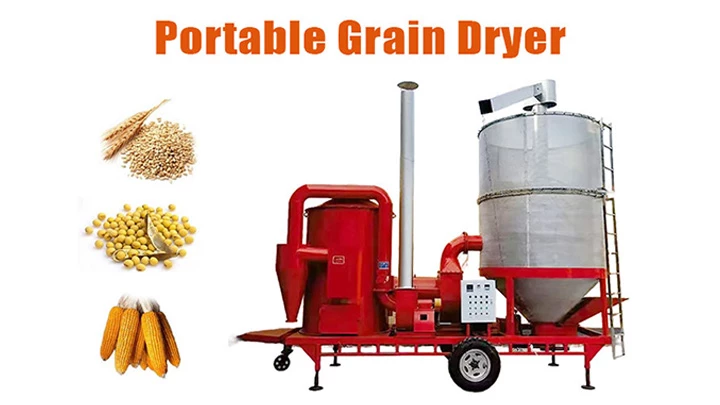
Mobile grain dryers are also known as portable grain dryers. It is designed for mobility and flexibility in grain drying operations.
Shuliy’s portable grain dryers are simply categorized based on the number of drying chambers into single-chamber and double-chamber models. Each type is further classified according to the size of the drying chambers.
If you are a medium to large farmer or agribusiness that needs to dry large quantities of grain efficiently, then you will need this mobile grain dryer. They can be mounted on a trailer or truck. And they can be easily moved from one location to another as needed.
Mobile grain dryers offer higher drying capacity, advanced control systems for temperature and airflow regulation, and automation features for monitoring and managing the drying process.
Shuliy has been specializing in the development of dryers for 14 years. We have advanced technologies in precision components and heating system design, such as hot air circulation drying, which is about 25.7% more energy-efficient compared to conventional dryers.
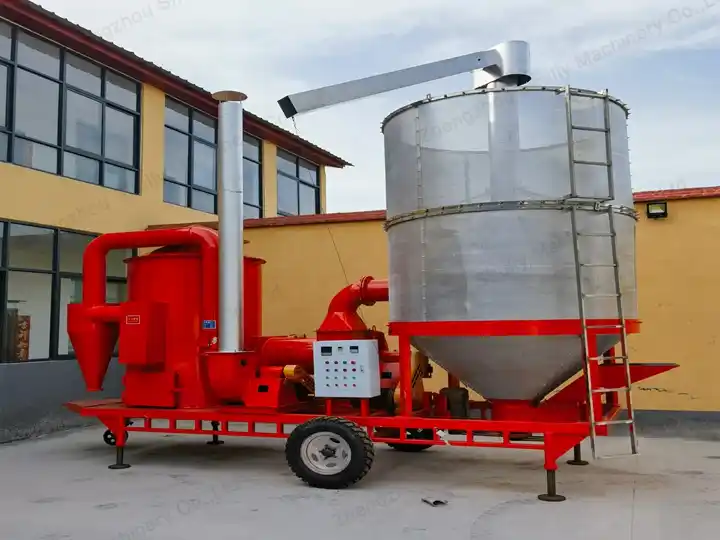
What kind of grains can be dried in this mobile grain dryer?
Mobile grain dryers can be used to dry corn, rice, millet, peanuts, rapeseed, soybeans, sorghum, wheat, and other granular materials. If you are not sure if your material can be used with this grain dryer, you can ask us through the contact information in the lower right corner.
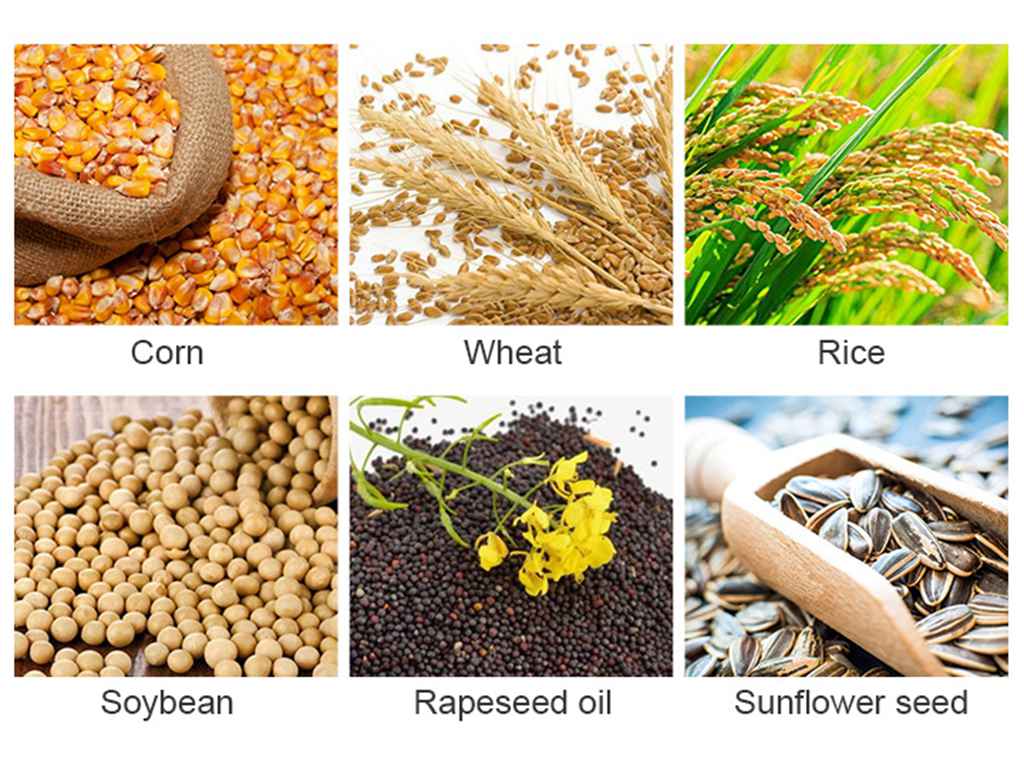
Portable grain dryer design
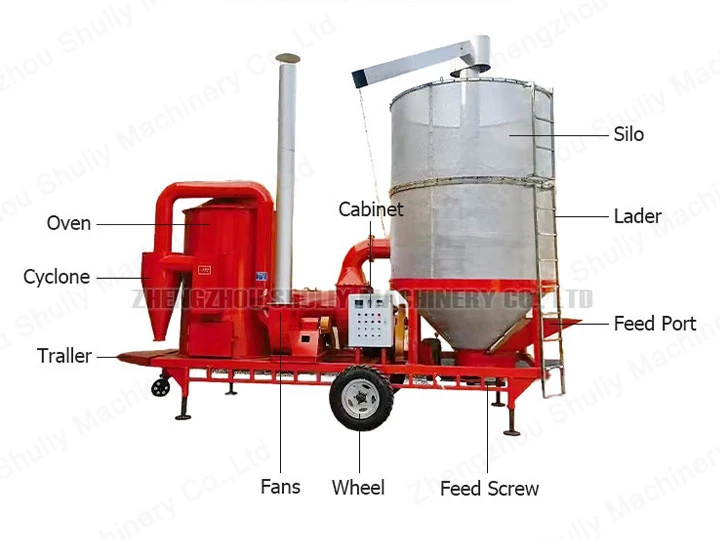
- Silo — Storage container for bulk grain or material
- Oven — Heating chamber or furnace where drying/heating occurs
- Cabinet — Control panel or enclosure for electrical components
- Ladder — Access ladder for maintenance or inspection
- Cyclone — Cyclone separator used for dust or particle removal
- Trailer — Mobile base or vehicle chassis for transport
- Feed Port — Entry point where raw material is fed into the machine
- Wheel Fans (better: Fans with Wheels or just Fans) — Fans for airflow, sometimes mounted on wheels for mobility
- Feed Screw — A Screw conveyor used to move materials into or through the machine
The mobile grain dryer consists of a drying chamber, a heating furnace, a fan system, a grain elevator, a control system, and a mobile chassis.
Drying Chamber
Used to hold the grain to be dried. It is equipped with ventilation holes and a hot air distribution system inside to ensure that the hot air penetrates the grain layer evenly for efficient drying.
Heating Furnace
Generates hot air by burning fuels such as firewood, coal, biomass pellets, diesel, or natural gas. It serves as the heat source for the entire drying process.
Fan System
Transports the hot air from the heating furnace into the drying chamber and distributes it evenly through the air ducts.
Screw Conveyor
Lifts the grain from the storage bin to the drying chamber, enabling automatic circulation and turning of the grain to ensure uniform drying.
Control System
Monitors and adjusts parameters such as drying temperature, airspeed, and drying time to achieve automated operation.
Mobile Chassis and Wheels
Supports the entire machine structure, facilitating towing by tractors or mechanical movement, suitable for operations in various field locations.
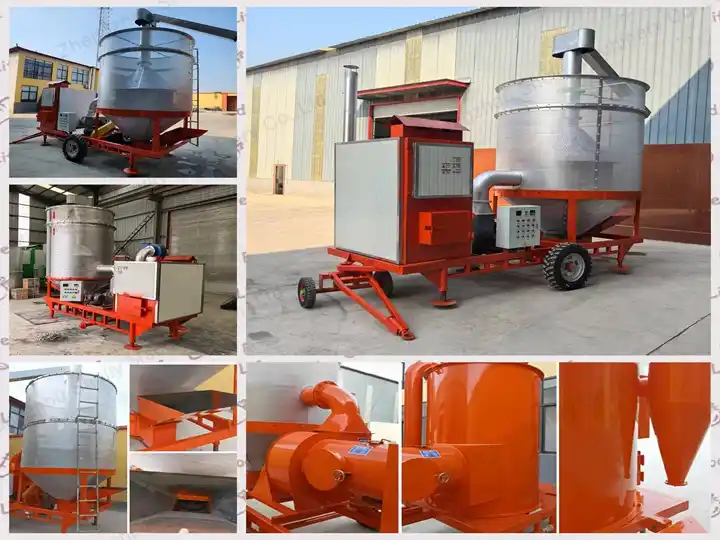
The advantages of the mobile grain dryer machine
- The silo of the mobile grain dryer machine is made of stainless steel.
- The machine is corrosion-resistant, abrasion-resistant, high hardness, sturdy, and durable.
- The machine will not rust and show large rust spots.
- Even after a year of continuous use, our machines are still brand new.
- The machine is equipped with removable wheels for easy mobility.
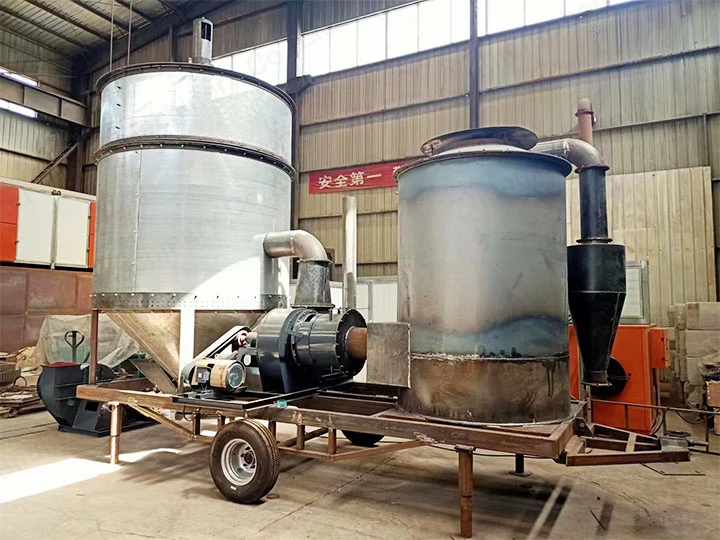
What are the heat sources for Shuliy’s mobile grain dryers?
Many conventional dryers only support electricity or diesel generators, but Shuliy’s mobile grain dryers support a wide range of heat sources, including coal, oil, methanol, biomass, electricity, and more.
Technical parameters of the Mobile grain dryer
Shuliy offers two types of portable mobile dryers: single-bin and double-bins models.
Single bin portable small grain dryer
The drying time for each bin ranges from 2.5 to 3 hours, including the time needed for grain loading and unloading. Each bin may experience some heat loss, resulting in slightly higher drying costs. However, these units have a small footprint, compact size, and are lightweight.
| single warehouse | Power/(KW) | Weight(T) | Outsize mm(LXWXH) | Output/T24hours |
| 1T | 8.3 | 2 | 4600*1800*3500 | 10T |
| 2T | 11 | 2.8 | 5100*2000*3800 | 20T |
| 4T | 19 | 4.5 | 5400*2100*3900 | 40T |
| 6T | 24 | 5.3 | 5600*2100*4300 | 60T |
| 8T | 28 | 6.5 | 6000*2100*5800 | 80T |
| 10T | 32 | 7.4 | 6200*2100*6400 | 100T |
This small grain dryer is suitable for small and medium-sized farms. The capacity of the grain dryer is in the range of 10 T to 100 T per day.
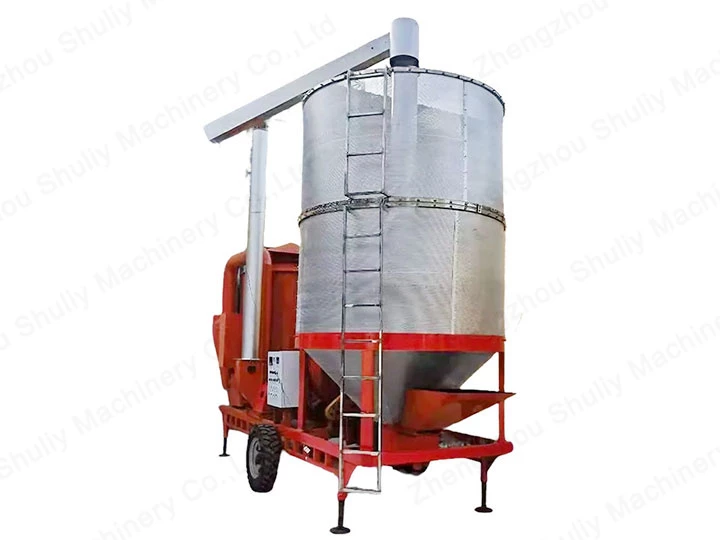
Double warehouse mobile grain drying machine
Each bin has a drying time of 2 hours. The two bins operate alternately for loading and unloading without any downtime, ensuring high output and efficient heat utilization, which significantly lowers the drying cost.
| double warehouse | Power/KW | Weight(T) | Outsize mm(LXWXH) | Output/T24hours |
| 2T+2T | 15 | 4.2 | 7500*2000*3800 | 40T |
| 4T+4T | 23 | 7 | 8500*2100*3800 | 80T |
| 6T+6T | 27 | 8.5 | 9500*2100*3900 | 120T |
| 8T+8T | 32 | 9.8 | 11000*2100*4300 | 160T |
| 12T+12T | 37 | 15 | 12000*2100*6800 | 240T |
The output of the double warehouse grain drying machine is 40T-240T per day.
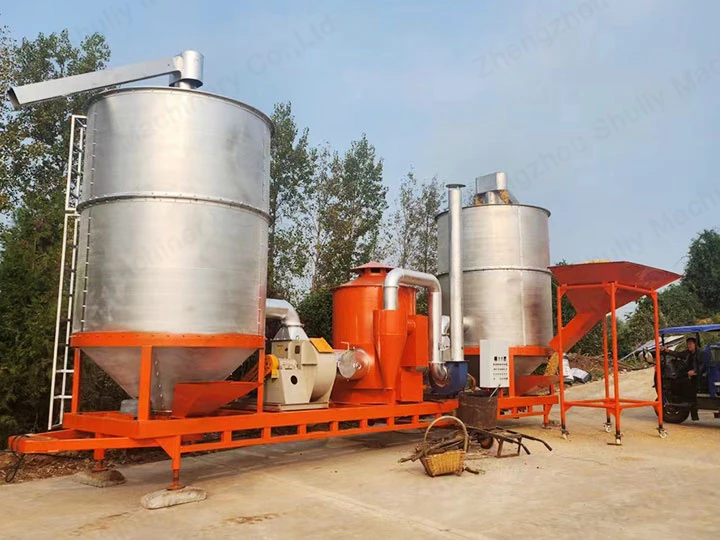
How do portable grain dryers work?
Portable grain dryers are innovative agricultural machines designed to efficiently reduce the moisture content of grains like wheat, corn, and rice.
These portable grain dryers operate by utilizing a combination of heat and airflow to create an optimal drying environment within their mobile structure.
The process begins when the grain is loaded into the dryer, where it is subjected to controlled heat generated by either propane or natural gas burners.
Simultaneously, powerful fans circulate heated air throughout the drying chamber, ensuring even and thorough drying of the grains.
Advanced control systems monitor and adjust key parameters such as temperature and airflow, allowing operators to optimize drying conditions based on the specific type and quantity of grain being processed.
In addition, portable grain dryers are equipped with features like moisture sensors and timers to precisely determine when the grains reach the desired moisture level, signaling the end of the drying cycle.
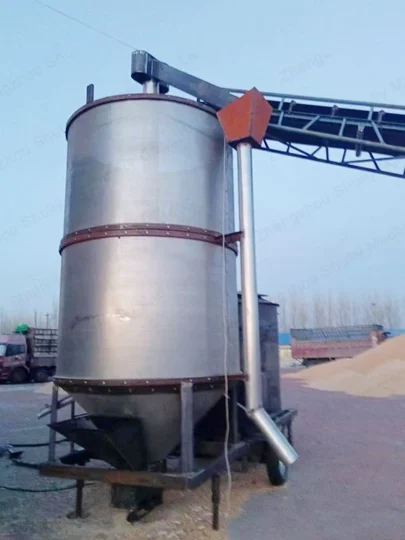
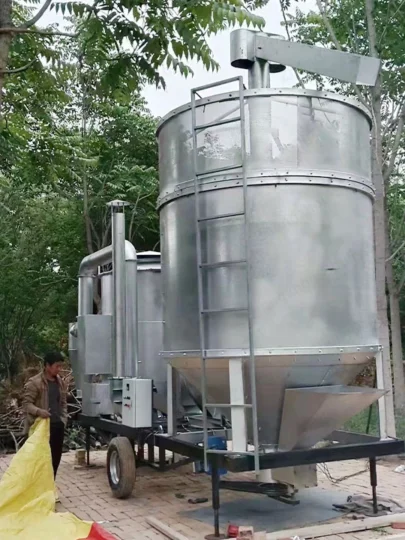
Mobile grain dryer for sale
At Shuliy Drying Plant, we have a wide range of mobile grain dryers for sale. The capacity of grain dryers ranges from 10 tons to 240 tons per day. You can choose the capacity of the grain dryer according to your needs. In addition, we have three different types of grain dryers for sale, including single-warehouse portable grain dryers, double-warehouse mobile grain dryers, and large vertical cereal dryers.
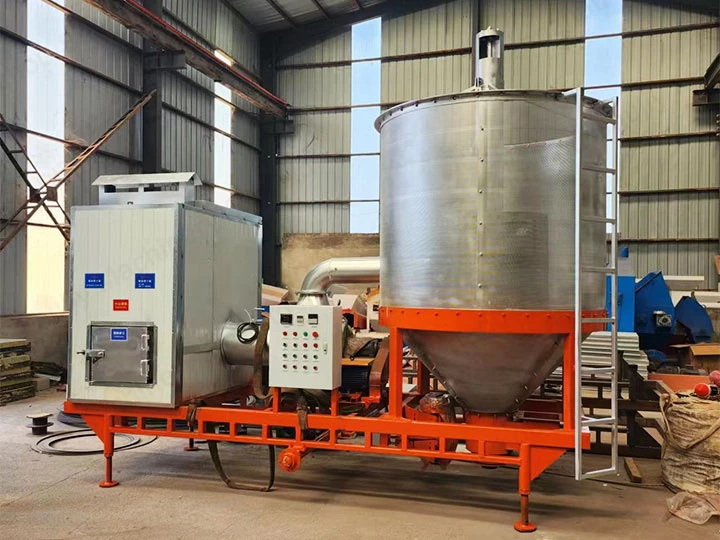
Different types of grain dryers
Single warehouse grain dryers have a drying time of 2.5-3 hours per bin. Compared with the double warehouse grain dryer, there will be excess heat wasted in each bin, so the cost of drying is slightly higher. But it has the advantages of a small footprint and being lightweight.
The drying time of a double warehouse grain dryer is 2 hours per bin. The two bins can load and discharge grain alternately. There is no interval time in between. The machine is characterized by high output. The heat generated during the working process of the machine can be fully utilized, which greatly reduces the drying cost.
Vertical grain dryer adopts low-temperature drying technology, which can dry 50 tons of grain per day. The machine adopts the design of using an angled air intake, which has the advantages of smooth ventilation, even drying and no need to clean up all year round.
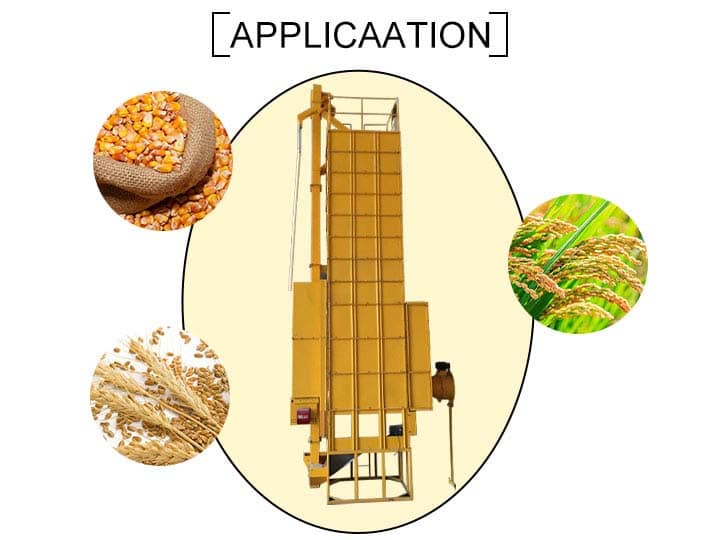
Mobile grain dryer VS. grain drying tower
Structure and Form
- Mobile Grain Dryer: Typically, a complete unit mounted on a wheeled chassis, towable or movable. It has a compact structure suitable for direct field operations.
- Grain Drying Tower: Usually a fixed, tall tower structure with a small footprint but significant height, commonly used in factories or grain storage facilities.
Mobility
- Mobile Grain Dryer: Highly mobile and flexible, it can be easily relocated to different sites.
- Grain Drying Tower: Fixed equipment, not designed for mobility.
Application Scenarios
- Mobile Grain Dryer: Suitable for farmers, family farms, and small grain processing plants, allowing rapid drying in the field during harvest season.
- Grain Drying Tower: Suitable for large grain storage facilities and processing plants for centralized, continuous drying operations.
Capacity
- Mobile Grain Dryer: Generally smaller capacity and output, suitable for small to medium-scale operations.
- Grain Drying Tower: Designed for large-scale, continuous grain drying.
Installation and Maintenance
- Mobile Grain Dryer: Easy to install and maintain, can be moved indoors for servicing, resulting in lower maintenance costs.
- Grain Drying Tower: Complex installation, occupies larger space, usually installed outdoors, with higher maintenance costs.
Noise
- Mobile Grain Dryer: Produces relatively low noise.
- Grain Drying Tower: Continuous operation generates higher noise levels.
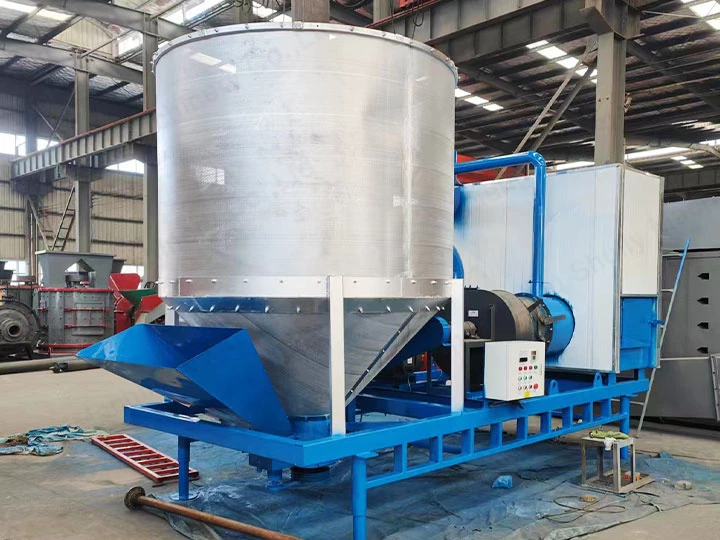
F&Q
How much does the grain dryer cost?
The price mainly depends on the storage capacity — smaller models are cheaper, while larger ones are more expensive.
What materials is the grain dryer made of?
The grain bin part of the dryer is made of stainless steel, while the heating section is made of carbon steel.
What are the advantages of stainless steel vs. galvanized steel?
* Stainless Steel: Resistant to corrosion caused by steam during operation. Even after seasonal use, it will not rust during storage and will be ready to use next year.
* Galvanized Steel: More affordable, but prone to rust over time.
Can it dry all kinds of crops? What is the drying temperature? Is the temperature adjustable?
Yes, it can dry corn, wheat, beans, rice, sorghum, and rapeseed. Our dryer uses hot air from vegetable oil combustion, which preserves grain quality and color, making it safe for consumption. The drying temperature can be controlled as needed.
Typical drying temperatures:
* Corn: 100–140°C (Northeast China ~140°C; South of Yellow River ~120–130°C)
* Wheat: 80–90°C
* Rice: 60–70°C
* Sorghum: 100–140°C
* Beans: 100°C
* Millet: 80°C (with 1mm mesh)
* Rapeseed: 100°C (with 1mm mesh)
How long does one batch take to dry? Will it damage the grain? What’s the machine’s lifespan?
One batch takes 2–3 hours. The machine uses a heat exchange system to dry the grain with hot air, which ensures even drying without damage. It can be used for over 5 years with proper maintenance.
What heat sources can customers use?
You can use coal, oil, methanol, biomass, or electricity as heat sources.
Which heat source is most cost-effective? What are the average costs?
* Coal: Most cost-effective; around 35–40 RMB per ton.
* Oil: About 50 RMB per ton.
* Electricity: Highest cost; around 100–120 kWh per ton. Usually only used by large grain depots * with their own transformer and government subsidies.
What’s the warranty period? Do you offer on-site installation if needed?
We offer a 1-year full machine warranty. If the customer is unfamiliar with the operation, we can provide on-site installation and commissioning, but travel and basic lodging expenses should be reimbursed.
